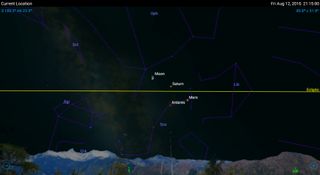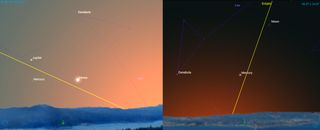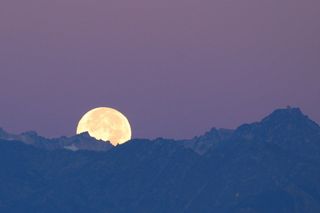How to Spot Mercury and the Solar System's 'Racetrack' Using Mobile Apps

In this column, we'll focus on the ecliptic, the invisible "racetrack" that hosts the sun, moon and planets. Knowing how it works and where to find it can make you a master planet spotter — you'll even be able to find the elusive Mercury!
Have you ever been without your trusty astronomy app and wondered, "Is that bright object a star or a planet?" Well, there's an easy way to find out: by using the ecliptic, the great circle across the sky that the sun, moon and planets follow. Earth's axial tilt shifts the ecliptic around throughout the year, but if you know how the ecliptic works, and where it lies in the sky, you can confidently identify the bright planets and even know when to look for Mercury.
This summer's parade of planets visible with the naked eye makes it especially easy to find the ecliptic. In this edition of mobile astronomy, we'll look at how it behaves and show you how to trace it across the sky to plan your planet hunting. [Planetfall: Wonders of the Solar System (Photos)]
The ecliptic, sun and zodiac relationship
All of the planets in our solar system orbit the sun more or less in the same plane. Only the 7-degree inclination of Mercury's orbit, and those of the distant Kuiper Belt objects, including Pluto, break this rule to any extent: those objects rise and fall through the plane as they orbit the sun, much like horses on a carousel. If the orbits of all the significant bodies in the solar system are averaged together into one master plane of rotation, the Earth's orbit falls close to the average, deviating by only 1.6 degrees.
For ground-based astronomers, it's simpler to use Earth's orbit as the reference plane. In this system, the sun's apparent path through the distant stars plots as a single great circle around the sky, known since ancient times as the ecliptic. As Earth orbits around the sun, the sun appears to move eastward along the ecliptic through the distant fixed stars, landing in the same star fields on the same dates every year.
Only 13 of the 88 standard constellations play host to the sun. Twelve of them make up the famous zodiac. The 13th is Ophiuchus, the serpent-bearer, situated above and between Scorpius and Sagittarius. Your favorite astronomy app will help you find this large but modest constellation. Located adjacent to the Milky Way, it contains quite a few interesting deep-sky objects — especially globular clusters, some of which are visible in binoculars and small telescopes.
While the sun sits on the ecliptic by definition, the moon and the naked-eye planets move along a strip of sky centered on the ecliptic, meaning that they're sometimes above it, sometimes below it and occasionally falling precisely on it. The latter situation gives rise to solar and lunar eclipses, as well as transits of the inner planets across the sun's disk. It also means that the moon and planets sometimes pass in front of, or occult, the prominent stars that lie within 5 degrees of the ecliptic.
Get the Space.com Newsletter
Breaking space news, the latest updates on rocket launches, skywatching events and more!

The varying ecliptic
The ecliptic crosses the sky as a large, curved arc from horizon to horizon. But due to the Earth's 23.44-degree axial tilt, its location in the sky varies depending on your latitude, the time of day and the date. For example, on the northern summer solstice, which occurs annually around June 21, the Earth's axis is tilted directly toward the sun, placing the sun and the ecliptic at their highest points in the daytime sky for the year. Correspondingly, the nighttime ecliptic sits at its lowest point for the year, so the angle where it meets both horizons is very shallow, affecting the visibility of Mercury (as we'll see below).
Planets visible during summertime evenings are always low in the sky, where we observe them through a thicker blanket of blurring atmosphere. Planets appearing in the winter sky are higher, where they shine through less atmosphere — the better for photographing them or viewing them in a telescope. The slow-moving planets Jupiter and Saturn take many years to migrate from summer to winter, and have been stuck low in the sky for some years now. But for Southern Hemisphere observers, these planets have been nice and high from their vantage point! ['Strawberry Moon': Amazing Photos of the Rare Summer Solstice Full Moon]
At the winter solstice, the nighttime ecliptic is very high in the sky, and the angle with both horizons is very steep. Between the solstices, the nighttime ecliptic crosses the sky somewhere between the two height extremes, and the angles with the horizon differ at morning and evening.
You can visualize the changes in your astronomy app. Disable the compass mode in the app, and switch on the ecliptic path. Manually swipe the display to bring the eastern sky into view; then, open the time controls and set the time of day near sunrise or sunset. Next, vary the date. Month by month should do it. (I like to use the 21st of the month to show the extreme cases.) Adjust a bit for the change in the length of the day with the seasons, and you'll see how the ecliptic moves about. You can also aim south and set the time to noon or midnight to see how the solar system objects vary in height throughout the year.

Regardless of the date, observers living north of 23°26'14" N, also called the Tropic of Cancer, always see the sun and the ecliptic in the southern half of the sky. Everyone living south of 23°26'14" S (The Tropic of Capricorn) sees the sun and ecliptic in the northern sky all year long. So the rule of thumb for North Americans seeking the ecliptic and all the planets is to start by looking south.
Tracing the ecliptic
Tracing the ecliptic across a clear evening sky is easier if the moon and bright planets are visible, but you can also use several bright stars or just your mobile astronomy app. Under the app's Settings menu, ensure that the planets are enabled and that the ecliptic is toggled on. Once you're outside, take note of where the sun has met the western horizon. That pins one end of the ecliptic. (You can also do this for a pre-dawn sky, noting where the sun's glow is building in the east.) Remember, for Northern Hemisphere observers, the ecliptic will be in the southern half of the sky.
If the moon is visible, the ecliptic will pass within 5 degrees of it. You can refer to your app to see whether the moon is above or below it. (Full moons always rise as the sun sets, pinning both ends of the ecliptic.) Bright planets will add more points of reference. Mars and Jupiter are always within 2 degrees (or two finger widths held at arm's length) of the ecliptic. Saturn and Venus wander a bit farther from it — 2.5 degrees and 3.4 degrees, respectively. This summer, Mars is sitting a few degrees south of the ecliptic, and Saturn is a couple of degrees above it. [August 2016 Skywatching — Planets, Constellations and Perseid Meteors (Video)]

You can also use prominent stars to trace the ecliptic. Here are a few that are visible at different times of the year. If you need help finding them, use your app to search for the names. Summer's bright-red star Antares in Scorpius always sits 4.5 degrees south of (below) the ecliptic. In fact, Antares' name, Latin for "rival of Mars," derives from its visual resemblance to the Red Planet and the occasional close encounters of the two objects. (The next one will occur toward the end of August this year.) Moving west, Libra's star Zubenelgenubi is only 20 arc-minutes to the north of the ecliptic, while the bright spring and summertime star Spica in Virgo sits only 2 degrees south of (below) it.
The bright star Regulus in Leo, visible in springtime, sits only 28 arc-minutes (about the moon's diameter, or a pinky-fingernail width held at arm's length) from the ecliptic. If you're finding the ecliptic during the winter months, use the center of the bright Pleiades cluster (also known as Messier 45) in Taurus. It lies exactly 4 degrees north of (above) it — and Taurus' brightest star, Aldebaran, sits only 5 degrees south of it. The naked-eye star Wasat in Gemini is even closer — only 10 arc-minutes (one-third of the moon's diameter) south of the ecliptic.
Once you think you have the ecliptic spotted, enable your astronomy app's compass mode to confirm it, and see if you can identify the zodiac constellations currently in view. The ecliptic's position shifts slowly from evening to evening, so you can take a peek every few weeks and watch the planets drift westward. You'll also be able to tell that the moon climbs higher in the sky as we head into autumn and winter. And the next time a friend points out a bright object in the southern sky, you'll be able to confirm that it's a planet and look for some others.
Spotting elusive Mercury
Most of the naked-eye planets are easy to spot, as long as they aren't in conjunction with the sun. The inner planets Venus and Mercury become hidden in the sun's glare twice as often as the outer planets — once when they are between Earth and the sun, and again when they are on the far side of the sun. Venus moves well away from the sun in between those times, making it easy to see for months at a time. Mercury, however, is another story. [The Mercury Transit of 2016 in Amazing Photos]
Understanding how the ecliptic changes location allows us to best determine when to look for the elusive planet Mercury. As the innermost planet, Mercury completes an orbit of the sun every 88 days, alternating between a morning object and an evening object as seen from Earth, and it remains visible for two to three weeks at a time. Astronomers refer to the periods of visibility as apparitions. Because Earth is moving, too, the intervals between them vary considerably from the 44 days one would expect.
Mercury is easiest to see when its orbit brings it to the maximum angle away from the sun. These are called elongations — western elongation for morning appearances, and eastern elongation for evening appearances. The separation angle is never sufficient for Mercury to climb very far from the eastern and western horizons and be clear of the dawn and dusk glow. The best we can hope for is that the planet will set well after the sun or that it will rise well before it. This is easier when the ecliptic makes a sharp angle with the horizon, because Mercury is more or less directly above the sun. But during times of the year when the ecliptic lies at a shallow angle to the horizon, the sun is barely out of sight before the planet follows it down.
There is one more complexity. The 7-degree tilt of Mercury's orbit allows it to drift well above or below the ecliptic. If the ecliptic is shallow but Mercury happens to be sitting above it, a mediocre apparition can become a decent one. But if Mercury is below an already shallow ecliptic, the planet will be extremely difficult to observe.
Early next week, on the evening of Aug. 18, Mercury reaches peak visibility for the current apparition. It's a poor one for Northern Hemisphere observers, however. The evening ecliptic is shallow, and Mercury is also 2 degrees below it. What makes the event worth a look is the addition of the bright planets Venus and Jupiter in the same area of the sky. Meanwhile, because the geometry flips upside down, Southern Hemisphere observers get their best view of Mercury for the year!
To help you plan your hunt for Mercury, set your SkySafari or other app to about 8:20 p.m. local time, and bring up the western horizon. You may need to change the app's selected landscape to one that provides a low horizon. For fun, enable the ecliptic path, too. You can adjust the app's time to determine when Mercury drops too low for your location. The days surrounding Aug. 18 will feature views of Mercury nearly as good, so start your attempts now, in case there are clouds next week. If you have binoculars or a telescope, you MUST ensure that the sun has completely disappeared below the horizon before using them in that area of the sky!
If you fail to find Mercury this time, another excellent opportunity will come in late September, when Mercury's morning apparition occurs with the ecliptic oriented nearly vertically above the eastern horizon. The planet will be rising about 90 minutes before the sun. As a bonus, on the mornings surrounding the peak of Sept. 28, the old crescent moon is nearby — landing only 1.5 degrees below the planet on Sept. 29.

You can use your mobile astronomy app to find future opportunities to spot Mercury, too. Select the planet, and then click the object information icon. In SkySafari, the next maximum elongation details are provided based on the current date. For future elongations, simply advance the app's date a month at a time, and click "info" again. By setting the app to the given elongation date and setting the time to "e" or "sunset," you can preview how the apparition will look and mark your calendar with the good ones. Good hunting!
Going beyond
Understanding the motions of the solar system demystifies a number of phenomena. For example, everyone has been captivated by the sight ofthe enormous Harvest Moon rising in the eastern evening sky in September. In fact, it's almost impossible to miss the September full moon because the evening ecliptic, around the time of the autumnal equinox in late September, sits nearly horizontal to the horizon. As a result, the moon, which normally rises about 50 minutes later every evening, is traveling almost horizontally eastward along the shallow ecliptic, and rises only about 30 minutes later each evening — making it highly likely you'll spot it during your regular after-dinner stroll or commute home from work, perhaps even a few days in a row! You can preview the effect by setting your astronomy app to 9 p.m. on Sept. 16 and then flowing the days forward and backward. Now, set the date to March 12, 2017, and do the same experiment. The moon rises more than an hour later every night. By the way, Harvest Moons are often depicted as yellow because additional dust in the atmosphere from rural harvesting operations tints the moonlight. [What Is A Harvest Moon? NASA Explains The Science (Video)]

The ecliptic, and the motions of the sun, moon and planets, can seem complicated at first, but your favorite mobile astronomy app is a powerful tool for demonstrating the effects and for learning how the universe works. In future editions of mobile astronomy, we'll look at advanced smartphone astrophotography, wirelessly controlling your telescope, product reviews and lots more. Until then, keep looking up!
Editor's note: Chris Vaughan is an astronomy public outreach and education specialist, and operator of the historic 1.88-meter David Dunlap Observatory telescope. You can reach him via email, and follow him on Twitter as @astrogeoguy, as well as on Facebook and Tumblr.
This article was provided by Simulation Curriculum, the leader in space science curriculum solutions and the makers of the SkySafari app for Android and iOS. Follow SkySafari on Twitter @SkySafariAstro. Follow us @Spacedotcom, Facebook and Google+. Original article on Space.com.
Join our Space Forums to keep talking space on the latest missions, night sky and more! And if you have a news tip, correction or comment, let us know at: community@space.com.
Chris Vaughan, aka @astrogeoguy, is an award-winning astronomer and Earth scientist with Astrogeo.ca, based near Toronto, Canada. He is a member of the Royal Astronomical Society of Canada and hosts their Insider's Guide to the Galaxy webcasts on YouTube. An avid visual astronomer, Chris operates the historic 74˝ telescope at the David Dunlap Observatory. He frequently organizes local star parties and solar astronomy sessions, and regularly delivers presentations about astronomy and Earth and planetary science, to students and the public in his Digital Starlab portable planetarium. His weekly Astronomy Skylights blog at www.AstroGeo.ca is enjoyed by readers worldwide. He is a regular contributor to SkyNews magazine, writes the monthly Night Sky Calendar for Space.com in cooperation with Simulation Curriculum, the creators of Starry Night and SkySafari, and content for several popular astronomy apps. His book "110 Things to See with a Telescope", was released in 2021.


